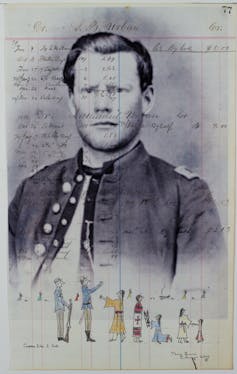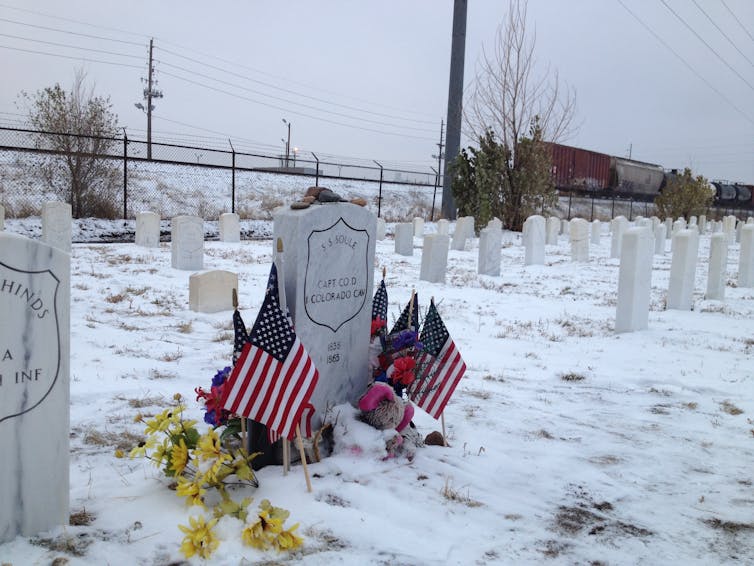
Experts in autocracies have pointed out that it is, unfortunately, easy to slip into normalizing the tyrant, hence it is important to hang on to outrage. These incidents which seem to call for the efforts of the Greek Furies (Erinyes) to come and deal with them will, I hope, help with that. As a reminder, though no one really knows how many there were supposed to be, the three names we have are Alecto, Megaera, and Tisiphone. These roughly translate as “unceasing,” “grudging,” and “vengeful destruction.”
This story is not a new one in any sense. The events it discusses go back over a hundred and fifty years, The article itself was first published three years ago. The Spiritual Healing Run which commemorates the events takes place at Thanksgiving time, so even that is six months out of date (or early for this year. And we are not yet at the anniversary, and if we were, it would be tht 155th But, in a week in which we are commemorating the 75th anniversary of D-Day, and, on the other hand, being appalled by a – person – bearing the title of President of the United States who thinks that pardoning war criminals is a good idea, I thought it would feel very timely.
========================================================
Remembering the US soldiers who refused orders to murder Native Americans at Sand Creek
Billy J. Stratton, University of Denver
Every Thanksgiving weekend for the past 18 years, Arapaho and Cheyenne youth lead a 180-mile relay from the Sand Creek Massacre National Historic Site to Denver.
The annual Sand Creek Massacre Spiritual Healing Run opens at the site of the Sand Creek Massacre near Eads, Colorado, with a sunrise ceremony honoring some 200 Arapaho and Cheyenne people who lost their lives in the infamous massacre. This brutal assault was carried out by Colonel John Chivington on Nov. 29, 1864.
While the Sand Creek massacre has been the subject of numerous books, much less attention has been given to two heroes of this horrific event: U.S. soldiers Captain Silas Soule and Lt. Joseph Cramer.

Courtesy of George Levi, Author provided
These were men who rejected the violence and genocide inherent in the “conquest of the West.” They did so by personally refusing to take part in the murder of peaceful people, while ordering the men under their command to stand down. Their example breaks the conventional frontier narrative that has come to define the clash between Colonial settlers and Native peoples as one of civilization versus savagery.
This is a theme I’ve previously addressed as a scholar in the fields of American Indian studies and Colonial history, both in my book on the Indian captivity narrative genre, “Buried in Shades of Night,” and more recently in writings on Sand Creek.
The letters of Soule and Cramer
Soule’s noble act of compassion at Sand Creek is humbly conveyed in a letter to his mother included in the Denver Public Library Western History Collections: “I was present at a Massacre of three hundred Indians mostly women and children… It was a horrable scene and I would not let my Company fire.”
Refusing to participate, Soule and the men of Company D of the First Colorado, along with Cramer of Company K, bore witness to the incomprehensible. Chivington’s attack soon descended into a frenzy of killing and mutilation, with soldiers taking scalps and other grisly trophies from the bodies of the dead. Soule was a devoted abolitionist and one dedicated to the rights of all people. He stayed true to his convictions in the face of insults and even a threat of hanging from Chivington the night before at Fort Lyon.
In the following weeks, Soule and Cramer wrote letters to Major Edward “Ned” Wyncoop, the previous commander at Fort Lyon who had dealt fairly with the Cheyenne and Arapaho. Both harshly condemned the massacre and the soldiers who carried it out. Soule’s letter details a meeting among officers on the eve of the attack in which he fervently condemned Chivington’s plans asserting “that any man who would take part in the murders, knowing the circumstances as we did, was a low lived cowardly son of a bitch.”
Describing the attack to Wynkoop, Soule wrote, “I refused to fire and swore that none but a coward would.” His letter goes on to describe the soldiers as “a perfect mob.”
This account is verified by Cramer’s letter. Detailing his own objections to Chivington, whom he describes as coming “like a thief in the dark,” Cramer had stated that he “thought it murder to jump them friendly Indians.” To this charge, Chivington had replied, “Damn any man or men who are in sympathy with them.”
In Soule’s account, he writes, “I tell you Ned it was hard to see little children on their knees have their brains beat out by men professing to be civilized.”
While few Americans – especially those living outside of Colorado – may know their names, Soule and Cramer are honored and revered by the descendants of the people they tried to save. According to David F. Halaas, former Colorado state historian and current historical consultant to the Northern Cheyenne, without their courage in disobeying Chivington’s orders and keeping their men from the massacre, “the descendants probably wouldn’t be around today,” and there would be no one to tell the stories.
The horrific descriptions of Soule and Cramer prompted several official inquiries into the atrocity. Both men also testified before an Army commission in Colorado as witnesses. While the officers and soldiers responsible escaped punishment, their testimony brought widespread condemnation upon Chivington, who defended the massacre for the rest of his life.
These investigations also ended the political career of the Colorado territorial governor, John Evans, who had issued two proclamations calling for violence against Native people of the plains, and for organizing the 3rd Colorado Cavalry Regiment in which Chivington was placed in command.
Sites of reverence and healing
The Cheyenne and Arapaho will return to Denver this year to honor their ancestors and remember Soule’s and Cramer’s conscience and humanity. This will be done through an offering of prayers and blessings, along with the performance of honor songs.

Billy J. Stratton, Author provided
On the third and final day of the healing run, they will gather for a sunrise ceremony at Soule’s flower-adorned grave at Denver’s Riverside Cemetery. The participants will then continue on to 15th and Lawrence Street in downtown Denver. There, a plaque is mounted on the side of an office building at the place where Soule was murdered on April 23, 1865. His death, for which no one was ever brought to justice, occurred only two months after he testified against Chivington before the Army commission.
Over the last few decades, Soule’s grave and place of death have been transformed into sacred sites of remembrance within a violent and traumatic frontier past.
The catastrophe of the Sand Creek Massacre is recognized by historians as among the most infamous events in the annals of the American West. Even now, it is the only massacre of Native people recognized as such by the U.S. government, with the land itself preserved as a national historic site for learning and reflection.
In Cheyenne and Arapaho stories, this event remains an ever-present trauma and persists as part of their cultural memory. In addition, it encapsulates the stark moment of betrayal against their ancestors and the theft of their lands.
The story of Soule’s and Cramer’s actions and their courage to say “no” to the killing of peaceful people at Sand Creek is an important chapter of U.S. history. I maintain that it is people like Soule and Cramer who truly deserve to be remembered through monuments and memorials, and can be a source for a different kind of historical understanding: one based not on abstract notions of justice and right, but upon the courage and integrity it takes to breathe life into those virtues.
On the 153nd anniversary of the Sand Creek Massacre, as we honor the memory of those who died at Sand Creek, may we also be inspired by the heroic actions of these two American soldiers.![]()
Billy J. Stratton, Professor of American Literature and Culture; Native American Studies, University of Denver
This article is republished from The Conversation under a Creative Commons license. Read the original article.
========================================================
Alecto, Megaera, and Tisiphone, in your Eumenides hats, help us remember this story of courage and self sacrifice, and how difficult it can be to do the right thing.
The Furies and I will be back.
Cross posted to Care2 HERE.
10 Responses to “Everyday Erinyes #169”
Sorry, the comment form is closed at this time.

I am humbled…. and very deeply saddened by this story, (as there are many other stories to share). The realization of what man’s capability and cruelty to our Native Tribes, their history, and in what they had to endure years ago, and still do… to this very day is heart-wrenching.
No words can bring them back, sadly, but actions (memorials) keeps history alive by telling and sharing the stark, brutal, inhumane treatment of our Native peoples. Soule’s and Cramer’s acts of courage to stand and resist the orders is commendable. Shame there weren’t others who would defy the orders. Oh! the horror and cruelty!
Thank you, Joanne (furies) for sharing this story.
We must remember our horrific treatment of the First Nations peoples. Also, the heroism and humanity of Captain Soule and Lieutenant Cramer should be much more well-known.
Although I lived in Denver for several years and knew about the brutality and atrocities of the Sand Creek Massacre, I had never heard of these heroes. Thanks, JD.
You can’t even visit Colorado for as long as a few weeks without hearing about the Sand Creek Massacre. But you can live here your entire life without ever hearing of Soule and Cramer (hubby had no idea, and he is 75, born here, lived here for all but about 3 years.) I didn’t know either. I thought it needed to be spread. Thanks (and YVW).
A remarkable story. One that will never be forgotten.
I was not aware of these two heroes, Captain Soule and Lt. Cramer. Bless them for rejecting the violence and standing up for the people.
Aghast! I’m deeply disheartened, disappointed and saddened in learning of another dark chapter in American history of ethnic genocide of Native Americans committed too often.
At the same time, I’m in awe, respect and reverence to the character, integrity, morality and bravery of Captain Silas Soule and Lt. Joseph Cramer by refusing to join in such actions.
This is a history totally unknown to me (and I suspect the majority of Americans). I thank you for bringing this dark chapter of our history to light!
WOW!!!
Your history in the US, almost identical to ours in Australia, ‘justified’ slaughter & genocide of our First Nations! 😥
And in true American style, the Hero who testified against the powers that be, was gunned down…. RESPECT!
Thank you for this Joanne, i didn’t know.
It did. Thanks for doing so.
Great posting. Those were true heroes!!!!
Truly informative and an excellent piece. I did not know about this but it does not surprise me. There is also the Trail of Tears and Wounded Knee, both genocides in my opinion. The treatment of indigenous peoples, whether in the US, Canada, Australia, New Zealand or elsewhere, has been deplorable.
Were there more like Captain Silas Soule and Lt Joseph Cramer who, by refusing to join in such actions, actually elevated the indigenous peoples. Unfortunately, heroes that they are, it is not enough as the genocide continued.